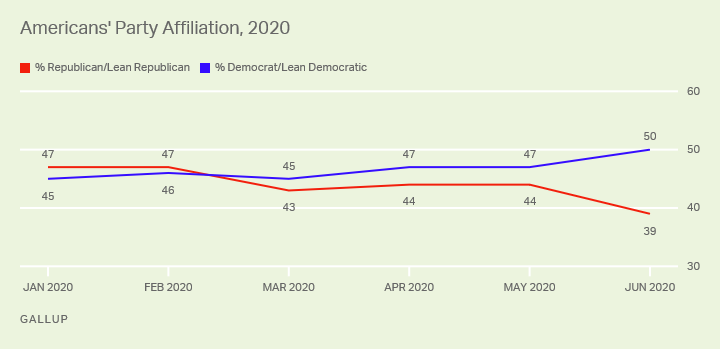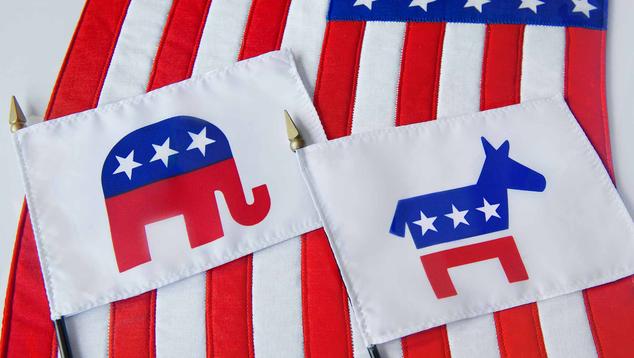Story Highlights
- Democrats now hold 11-point advantage in party affiliation
- Republicans held a two-point edge in January
- Democratic lead similar to what it was in 2018
WASHINGTON, D.C. -- Since January, Americans' party preferences have shifted dramatically in the Democratic Party's direction. What had been a two-percentage-point Republican advantage in U.S. party identification and leaning has become an 11-point Democratic advantage, with more of that movement reflecting a loss in Republican identification and leaning (down eight points) than a gain in Democratic identification and leaning (up five points).

Line graph. Fifty percent of Americans identify as Democrats or are independents who lean toward the Democratic Party while 39% are Republicans or Republican leaning independents. In January, 47% were Republicans or Republican leaners and 45% were Democrats and Democratic leaners.
Currently, half of U.S. adults identify as Democrats (32%) or are independents who lean toward the Democratic Party (18%). Meanwhile, 39% identify as Republicans (26%) or are Republican leaners (13%).
These results are based on monthly averages of Gallup U.S. telephone surveys in 2020.
In January and February, the months in which the U.S. Senate tried and acquitted President Donald Trump on impeachment charges brought by the House of Representatives, slightly more Americans preferred the Republican Party to the Democratic Party.
In March, as the nation began to deal with the effects of the coronavirus pandemic, Democrats gained a slight two-point advantage, which persisted in April and May.
The greatest movement occurred in June -- likely because of increased attention to racial injustice that followed the death of George Floyd while in police custody on May 25, as well as increased U.S. struggles to contain the coronavirus spread.
In June alone, there was a three-point increase in Democratic identification and leaning, and a corresponding five-point drop in Republican identification and leaning.
Double-Digit Advantages Are Uncommon
Democrats typically hold an advantage over Republicans in party affiliation, which has averaged five points since Gallup regularly began measuring party identification and leaning in 1991. Double-digit Democratic advantages have been relatively uncommon.
The party last held an advantage of 10 points or more in January 2019 (51% to 39%), when Democrats were installed as the majority party in the House of Representatives after their success in the 2018 midterm elections. Democrats and Democratic leaners also outnumbered Republicans and Republican leaners by 10 points or more in several months in 2018, including in October (51% to 41%) just before those elections.
Other times when Americans' party preferences favored Democrats by more than 10 points over Republicans were:
- in December 2012, after Barack Obama was elected to a second term and the nation dealt with the Sandy Hook Elementary School shooting tragedy.
- throughout much of George W. Bush's second term as president, when his job approval ratings were low. In fact, in the calendar years 2006, 2007 and 2008, Democrats' average edge in party affiliation was 10 points or more. During this time, Democrats scored major victories in the 2006 and 2008 elections, which led to them having control of the White House and large majorities in both houses of Congress in 2009.
- during Bill Clinton's second term, when the economy was strong -- but particularly from December 1998 to February 1999, when he was impeached by the House and acquitted by the Senate. This included 13-point Democratic advantages in December 1998 and January 1999 and an 11-point edge in February 1999.
- near the end of George H.W. Bush's term, beginning in the summer of 1992 after the Democratic convention that year, through the first full month of Clinton's presidency in 1993. Clinton defeated the incumbent Bush in the November 1992 election by tying him to the struggling economy.
The Republican Party has yet to average a 10-point or better advantage in party identification or leaning for an entire month since Gallup began regularly measuring independents' political leanings in late 1991. There were multiple Gallup polls with 10-point GOP advantages in March 1991 after the U.S. victory in the Persian Gulf War, but Gallup did not measure independents' political leanings in other polls taken that month, so the data are incomplete. The largest GOP advantage Gallup has measured for a complete month was eight points in December 1994, after the major Republican victories in that year's midterm elections.
Implications
Four months before Election Day, Democrats appear to be as strong politically now as they were in 2018 when they reclaimed the majority in the House of Representatives and gained seven governorships they previously did not hold. If the strong current Democratic positioning holds through Election Day, Democrats could build off those 2018 successes to possibly win the presidency and Senate in 2020. Many GOP senators up for reelection this year were last elected in 2014, a favorable year for Republicans, and appear to be facing a much more challenging political environment than six years ago. At the same time, Trump -- with a job approval rating currently below 40% -- appears vulnerable to being denied a second term.
This year has been an eventful one, politically. Trump's impeachment acquittal and a strong economy in January and February seemed to benefit the Republican Party. The coronavirus pandemic changed things suddenly, but the public initially rallied behind its leaders. After the public became critical of Trump's handling of the situation and Floyd's killing made racial injustice a major public issue, Americans became increasingly likely to align themselves with the Democratic Party. Whether the current political environment holds or takes another unexpected turn will help determine the balance of power in 2021.
Learn more about public opinion metrics that matter for the 2020 presidential election at Gallup's 2020 Presidential Election Center.
Learn more about how the Gallup Poll Social Series works.




